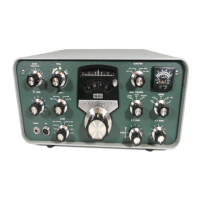Measure the Heterodyne Oscillator level on all bands (looking for dead crystals or gross
tuning issues).
Check that both USB and LSB oscillators function and log the level (note: the plate load
resistors may have drifted higher in value reducing the oscillator output level)
b.3. Receiver Alignment
Refer to the section Receiver Alignment on page 31 for the complete receiver alignment
procedure.
With no antenna connected (or switched to a dummy load), adjust the “S” meter
adjustment to read “S0”.
Observe “S” Meter behavior as radio warms up. “S” meter drift is a common problem. If
excessive “S” meter drift is observed check the following items:
Resistors in metering circuit, especially the 22k (or 33k) in 1
st
IF screen circuit, 100k from 1
st
IF
screen to “S” meter adjust pot. The 22k (or 33k) resistor should be a 2-watt resistor for
stability.
Also check AGC voltage at RF Amp, 1
st
RX Mixer and 1
st
IF amp. A positive voltage at any of these
points is probably indicative of a gassy tube or one with grid emission. It is also possible that
there could be a leaky coupling cap to the grid, but this does not appear to be common.
b.4. Transmit Alignment
Refer to the section Transmitter Alignment on page 34 for the complete transmitter
alignment procedure.
Measure and record RF watts out on each band using dummy load/wattmeter.
Check CW keying and sidetone oscillator. Adjust sidetone volume to a comfortable level
2-Tone IMD measurement using spectrum analyzer (optional)
b.5. Meter Checks
Verify correct meter operation in all positions
“S” Meter
High Voltage
Grid Current
Plate Current
ALC
Relative Output
b.6. Final Checks (optional)
Measure and record receiver stage gains (see Signal Level Measurements on page 41).
General Inspection and Restoration Checklist revised 12/17/2021 Page 24

